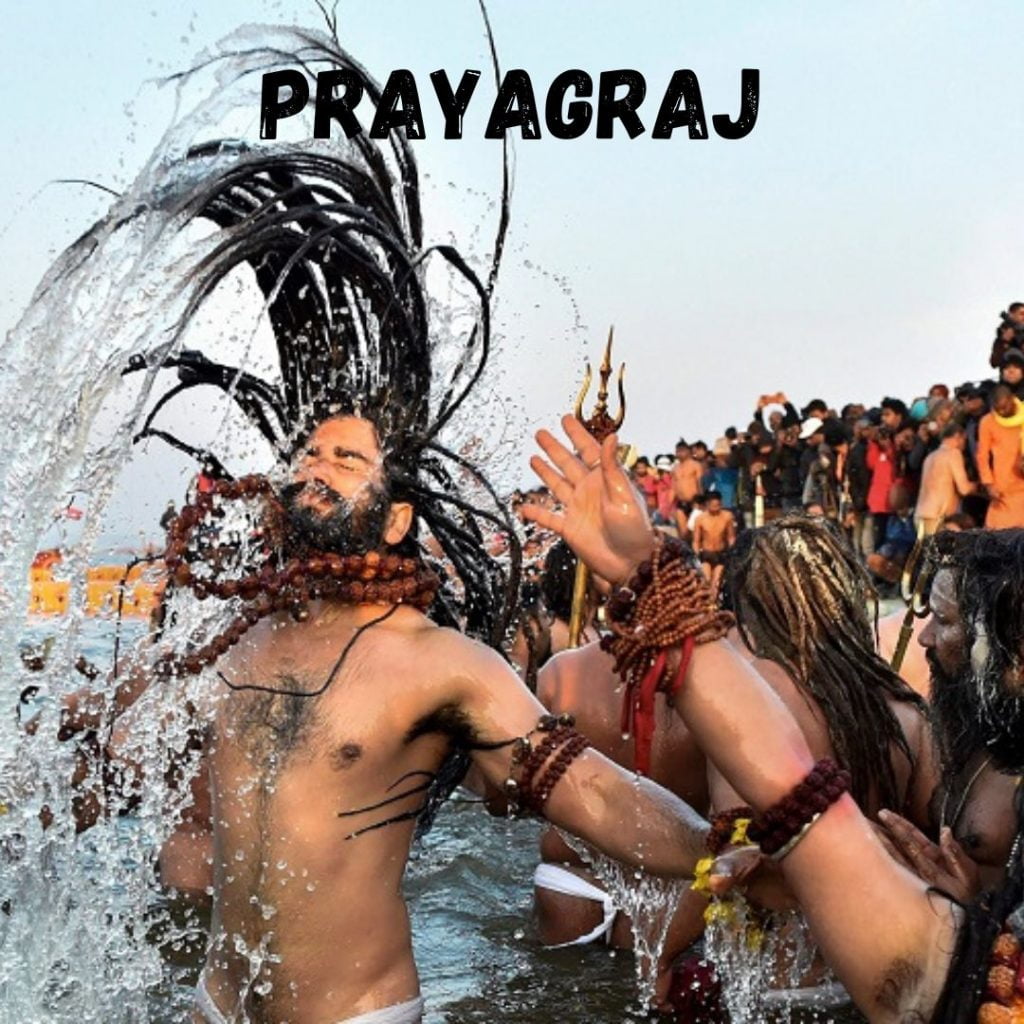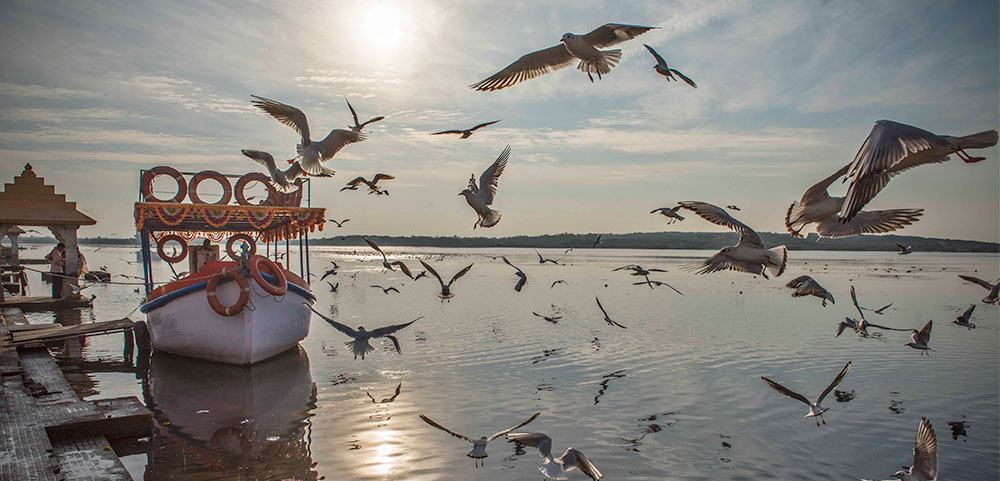Magh Mela in Prayagraj
While the grand spectacle of the Kumbh Mela often overshadows it, the Magh Mela in Prayagraj remains one of India’s most sacred and spiritually intense gatherings. Held annually on the banks of the Triveni Sangam—the confluence of the Ganga, Yamuna, and the mystical Saraswati—the Magh Mela attracts thousands of saints, sages, spiritual seekers, and common devotees who brave the cold for a month-long spiritual sojourn.
This detailed guide explores the rituals, significance, mythological roots, and experience of this lesser-known but deeply revered Hindu festival.

Magh Mela in Prayagraj
What is Magh Mela?
Magh Mela is an annual pilgrimage and bathing festival held during the Hindu month of Magh (January–February). It is considered an Ardha Kumbh in years when the full Kumbh is not scheduled. Rooted in ancient Vedic traditions, the Magh Mela is a month-long spiritual retreat that involves ritual bathing, religious discourses, prayers, charity, and austerity.
It’s not just a fair; it’s a Tapasya (penance)—a sacred vow where pilgrims, known as Kalpvasis, live on the banks of the Sangam for 30 days, practicing strict asceticism and devotion.
Spiritual Significance of the Magh Mela
According to the Puranas, Lord Brahma performed a sacred yajna at the Sangam during this period, sanctifying the land forever. Bathing during Magh is believed to grant:
- Freedom from sins of past lives.
- Peace to departed ancestors.
- Spiritual awakening and mental purification.
- Accumulation of immense punya (divine merit).
The belief is that a single dip in the icy waters of Sangam during Magh month is equivalent to performing a thousand yajnas and donating gold equal to one’s body weight.
Important Bathing Dates of Magh Mela
Although pilgrims bathe daily throughout the month, specific dates are considered highly auspicious, attracting massive crowds:
- Makar Sankranti – First and most sacred snan (holy dip) marking the Sun’s transition into Capricorn.
- Paush Purnima – Marks the beginning of Kalpvas.
- Mauni Amavasya – The holiest bathing day, ideal for ancestral offerings and deep silence.
- Basant Panchami – Celebrated in honor of Goddess Saraswati, representing wisdom.
- Maghi Poornima – Final major bathing day, often signifying the culmination of Kalpvas.
- Maha Shivratri – Devotees perform Shiva worship alongside the bath.
Who Are the Kalpvasis?
A unique feature of Magh Mela is the presence of Kalpvasis—devotees who give up worldly comforts for one full lunar month to engage in:
- Daily ritual baths at sunrise
- Chanting and reading scriptures
- Sleeping on the ground
- Consuming sattvic food only once a day
- Silence and celibacy
This act is a mini-renunciation, said to bring the spiritual benefits of a complete life of penance. The Kalpvas tradition is one of the oldest and purest forms of Hindu spiritual practice.
What to Expect at the Magh Mela Camps
The Magh Mela grounds stretch across several kilometers near the Sangam and resemble a pop-up spiritual township, complete with:
1. Ashrams and Akharas
Renowned spiritual leaders, gurus, and sects like Juna Akhara, Niranjani Akhara, and Vaishnav Mahasabhas set up camps. They host:
- Bhajan-kirtans
- Public discourses
- Yagyas and rituals
- Free food (langars)
2. Tent Accommodations
Kalpvasis and pilgrims stay in canvas tents, built with minimal facilities but profound spiritual vibes. Some camps offer eco-friendly and affordable stay options with basic meals.
3. Spiritual Marketplace
The mela has stalls selling religious books, rudraksha malas, Ayurvedic medicines, and local handicrafts, creating a sacred bazaar of sorts.
Cultural and Devotional Activities
Magh Mela isn’t limited to ritual bathing alone. It’s a spiritual celebration, rich in culture, colors, and community. Key highlights include:
- Evening Ganga Aarti at the ghats
- Ramayan and Bhagwat Katha sessions
- Satsangs and bhajans by revered saints
- Theater performances on mythological themes
- Charitable camps offering free checkups, food, and education
This creates a deeply immersive experience, especially for those on a spiritual journey of self-discovery.
The Sangam Snan Experience
The central ritual of Magh Mela is the early morning holy dip in the Triveni Sangam.
How It Happens:
- Pilgrims board boats before sunrise.
- Boats anchor near the confluence point.
- Devotees take three dips while chanting mantras and praying.
- Tarpan and pind daan are performed for ancestors.
- Many carry Ganga jal back home as a blessing.
The experience of bathing in freezing water under the crimson dawn, amid thousands of voices chanting “Har Har Gange,” is profoundly spiritual and transformative.
Mythological Roots of the Magh Mela
The Skanda Purana, Matsya Purana, and other ancient texts mention the significance of Magh month as the time when gods descend to Earth to bathe in the Sangam. It’s believed that even Devas, Rishis, and Pitrs (ancestors) gather here invisibly to participate in the spiritual energy.
The Magh Mela also pays homage to:
- The penance of Rishi Markandeya
- The tapasya of Bhagirath, who brought Ganga to Earth
- The karmic cleansing of King Harishchandra
Travel & Practical Information for Visitors
1. How to Reach:
- By Air: Closest airport is Prayagraj Airport (Bamrauli), well-connected to Delhi and major cities.
- By Train: Prayagraj Junction, Rambagh and Cheoki stations serve thousands of pilgrims.
- By Road: Regular buses from Varanasi, Lucknow, and Allahabad to the Sangam area.
2. Where to Stay:
- Budget lodges and Kalpvas camps on the Mela ground.
- Hotels and guesthouses near Civil Lines and MG Marg for comfort-seeking visitors.
- Book early during peak bathing days.
3. What to Carry:
- Warm clothes (mornings are freezing)
- Personal puja items and a waterproof bag
- Identity documents
- Basic medical kit
A Lesser-Known Gem for Photographers & Culture Seekers
The austerity of Kalpvasis, the spiritual fervor, the colors of sunrise, and the silhouettes of sadhus make the Magh Mela an unparalleled destination for photographers, writers, and spiritual travelers.
It’s quieter than the Kumbh, yet equally divine. There are fewer crowds, more opportunities for inner exploration, and a genuinely raw, sacred atmosphere.
Conclusion: Why Magh Mela Matters
In a world constantly buzzing with noise and speed, the Magh Mela offers silence, simplicity, and soul-stirring energy. It’s a retreat for the spirit, away from material distractions, where one can dip not just the body, but the soul into a pool of divine grace.
Whether you’re a pilgrim, a seeker, or a curious traveler, the Magh Mela at Prayagraj is a rare window into India’s living spiritual traditions—authentic, vibrant, and timeless.

